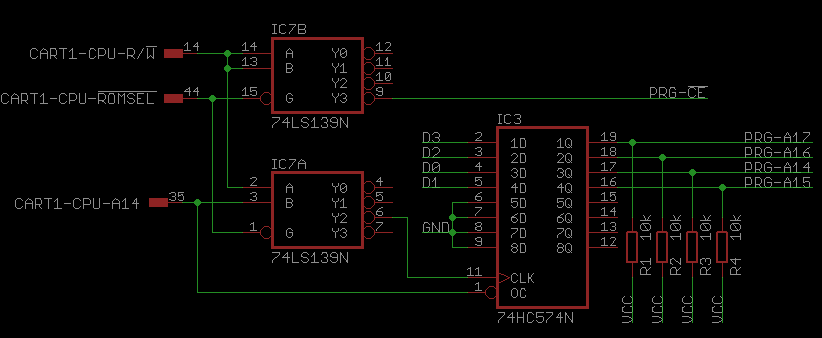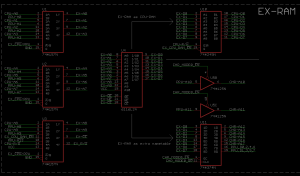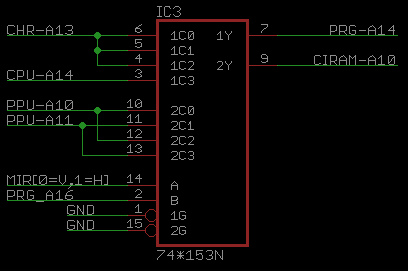Implementing Mappers In Hardware: Difference between revisions
Krzysiobal (talk | contribs) (Added info about interrupt generation, alternate mirroring switch and one useful llink to forum) |
Krzysiobal (talk | contribs) mNo edit summary |
||
| Line 188: | Line 188: | ||
==13.Cycle counter and interrupt notification== | ==13.Cycle counter and interrupt notification== | ||
Cycle counter and interrupt notification are rare features of discrete mappers, because | Cycle counter and interrupt notification are rare features of discrete mappers, because they need quite a lot of chips. Things that can be counted are: video scanlines, CPU cycles or PPU cycles. Scanline counting is useful for notifying via interrupt about incoming scanline in order to switch nametables and/or CHR banks. The main use is to generate complex graphics that uses more than 256 tiles per screen or status bars. Schematics for the whole thing might be like below: | ||
<pre> | <pre> | ||
___________ ______________ | ___________ ______________ | ||
| Line 214: | Line 214: | ||
* address decoder - generating enable signals for each of the blocks above on the basis of CPU address | * address decoder - generating enable signals for each of the blocks above on the basis of CPU address | ||
In the schematics | In the schematics below, there is some logic which counts PPU scanlines. PAL16L8 is used for address decoder & interrupt generation and acknowledgment. Also, scanline number is fixed to 78. | ||
[[File:Kid dracula scanline.png]] | [[File:Kid dracula scanline.png]] | ||
Revision as of 11:35, 27 May 2017
With increased popularity of programmable logic devices (CPLD/FPGA), almost any mapper implementation can be done in just one chip with some additional components for:
- logic level translating (5 V from cart connector signal to 3.3 V),
- recovering !RESET signal from M2,
- protecting PRG-RAM against data corruption due to PRG-!CE and M2 delay,
- battery backing-up PRG-RAM,
- providing additional audio channels (AY-8910 or similar chips).
However, most CPLD/FPGA chips come in dense packages, which makes soldering them hard for beginners. Also, they need 2.5 V and/or 3.3 V power supply and logic levels-translators, which might discourage using them for simple mapper reproduction. Learning how to implement some mappers using discrete chips (74 and 40 family) might be more economical for some uses. Also, it is good educational exercise for understanding:
- how console works and how to interact with CPU and PPU on hardware level,
- which signals need to be used and how much resources it would take to express the same in programmable logic devices.
A lot of bootleg (pirate) cart reproductions were done using 74 and 40 families chips, because that was the only way to mimic the behavior of ASIC mappers like MMC1 or MMC3 at that time.
This page shows some tricks and solutions for common problems during implementing logic using discrete circuits. Exclamation mark placed at beginning of signal names makes them active low (inverted logic) - for example: !OE or CPU_R/!W
0. IC chips technologies
Before starting to build something using discrete chips one needs to know that various technologies of those chips exist (TTL -> LS, CMOS -> HC) and they should not be mixed, because their input and output voltage range is not compatible. Also be advised, that when using CMOS chips, you should place capacitor close to power supply pin of every chip (100 nF ceramic one should be enough) plus one bigger electrolytic capacitor for the whole cartridge. Finally, all unused inputs of CMOS devices should be tied to some known state (GND, VCC or any other signal). In contrast, TTL unused inputs can be left unconnected without any harm. Unconnected TTL input will have logic value of '1'.
1. Recovering !RESET signal from M2
Most CPLD/FPGA chips can be programmed in a way that their internal registers have predefined value upon power-up. In contrary, 74XX chips have unknown (random) internal state and they need to be put to reset after power-up for a while. There is no !RESET signal on the cartridge edge, but M2 CPU clock signal (which is oscillating at ≈ 1.8 MHz during normal work and is held in high impedance when CPU is being reset) can be used for that purpose. The following circuit recovers !RESET from M2:
VCC
|
C (1n)
|
M2---►|---+----- `recovered` !RESET
| ('0' when console is in reset)
R (4.7k)
|
GND
When M2 is oscillating, there is:
- '1' at output (when M2 is '1') because C is discharged through the diode,
- '1' at output (when M2 is '0') because diode protects !RESET from dropping to '0', but C is slowly charged through R.
When M2 stops oscillating for a longer period of time (high impedance state or '0'), C will be charged through R and the voltage at output will be slowly falling and finally it will reach '0' level. Manipulating R*C can shorten or lengthen that period.
Pros:
- Can be used as asynchronous reset for both 7400 family and FPGA devices.
Cons:
- The signal at the output has slow rise time and cannot be used as a clock to sequential logic (for example, when you want to switch to next game in your multi-cart after each reset), because it might produce multiple oscillations during its rising and falling edge. Solution: put additional Schmitt gate (eg. 7414) at such sequential logic input:
_ | \ `recovered` reset---------|S >------input to seqiential logic |_/
Source: 168-in-1 (and almost any other) multicart.
2. Using high-impedance + pull up for last-fixed bank
Normally, when you want to make some CPU memory region (eg. $C000-$FFFF like in UNROM) to be fixed to the last bank, you should OR the PRG address lines with CPU-A14:
REGISTER |------------+ ____ | bit0 |------------------) OR )------PRG_A14 | | CPU_A14-)____) | | ____ | bit1 |------------------) OR )------PRG_A15 | | CPU_A14-)____) | | ____ | bit2 |------------------) OR )------PRG_A16 |------------+ CPU_A14-)____)
If you want to eliminate need of using OR gate and your REGISTER has three-state outputs, you can pull-up its output to VCC so that when they're disabled, all PRG lines are fixed to '1'. Instead of using discrete resistors, you can use pull-up ladder (R can be 10k)
VCC VCC VCC
REGISTER | | |
+------------+ R R R
| bit0 |-----------+-----------PRG_A14
| | | |
| | | |
| bit1 |---------------+-------PRG_A15
| | |
| | |
| bit2 |-------------------+---PRG_A16
| |
CPU_A14---| !OE |
+------------+
Pros:
- allow you to save one chip,
- might make routing signals easier
Cons:
- '0' to '1' transition edge (switching output off) is slower, because external capacitance is preloaded through large R. However, it should not cause problems as most of memories are 200 ns or less. You can speed the edge up by lowering R value
Source: Sangokushi 2 pirate MMC5 bootleg
3. Using 74139 as address decoder and for eliminating bus conflicts
When you want to implement something with more than one register (or one register but not placing it in whole $8000-$ffff), you need some kind of address-decoding circuitry which takes A14, CPU_R/!W and maybe other lines into account. Also, eliminating bus conflicts also needs to take CPU_R/!W into account which might need of use lot of combinatorial logic.
74139 which is two 4-to-2 decoder can be used to both decode address and as some way of combinatorial logic. For example, implementing Camerica 71 mapper (single reg placed at $C000-$FFFF + no bus conflict) would need only 74574 register + 74139 decoder + pull-up regs:

Source: my own work
4. Protect registers from accidental writing
When you are making multi-cart, you will probably have to create some registers for selecting games (PRG and CHR), mirroring and put them in $8000-$ffff. But when the user selects game and you do JMP ($fffc), you don't know whether the game doesn't also write to $8000-$ffff, which might change currently selected bank and contribute to CPU hang. To protect against that situation, you need to block any succesive writes to $8000-$ffff from changing currently stored value in yours register. Easiest solution is to make one bit of your register as a LOCK BIT and then OR it with original register write strobe. When LOCK BIT is '1', affective register write strobe will remain '1' no matter what happens (until CPU reset). Don't forget to clear this bit (or whole register) on CPU reset.
__________
| REGISTER |
DATA -| |---- TO PRG_A/CHR_A
and/or -| |---- or other logic
ADDRESS bus -|LOCK BIT |-+
_________________________ __ | | |
--signals-----| combinatorial logic for |--+-------)OR)---|wr clock | |
--from cart---| generating register | | +-)__) |__________| |
--edge--------| write strobe | C | |
|_________________________| | +---------------------+
GND
Notes:
- C (tens or hundreds of pF) might be useful if not all input signals change at the same time to prevent short glitches at output.
Source: 4-in-1 multicart
5. Protect CHR-RAM from being overwritten
If you plan to make flash-cart or repro, but instead of putting CHR-ROM you want to put CHR-RAM and fill it with pattern tables through PPUADDR/PPUDATA, it is OK (other way would be to put flash CHR-ROM and program it through PPUADDR/PPUDATA using magic 0x555/0xAAA/PA programming sequences, but that would be 10 times slower). However, there are some games, which are designed to be using CHR-ROM but they're still forcing PPU to write something to $0000-$1FFF, which cause overwriting some tiles. To protect against that, you should make one bit of your register as CHR_RAM_LOCK bit:
______________
| REGISTER | CHR_RAM
| | __ _______
|CHR_RAM_LOCK |-------------)OR)_________|!CS
| | PPU_A13--)__) |
|______________| PPU_!RD--|!OE
PPU_!WR--|!WE
|_______
Source: 168-in-1 multicart (it does something like that although it uses PAL circuitry for combinatorial logic)
6.Building complicated logic formulas
When constructing complicated logic expressions (eg. address decoders), you might need a lot of AND/NAND/OR/NOR/EXOR gates to build them. Theoretically, all logic formulas can be build using only NAND gates, but sometimes you would need so many of them it would be really impractical. 74688 is a 8-bit comparator (with additional output enable) which might be extremely useful for address decoding purposes. If you want to build even more complicated decoders, you can:
- use some kind of programmable logic (PAL, GAL, CPLD). Although, the first two are rather hard to find and program,
- use EPROM/Flash as a cheap-man's PLD. A memory with address bus of width `n` and data bus of width `m` can be used to build ANY `n` input and `m` output combinatoric logic. It can also be used to build sequential logic (when connecting data outputs to address inputs), but you need to be aware of transient states to make it work.
Source: http://hackaday.com/2017/02/02/the-gray-1-a-computer-composed-entirely-of-rom-and-ram/
7. Implementing lot of registers using 74670 dual port memory
A lot of mappers have more than one register (for example - MMC3 has 8 registers just for controlling CHR banks). Theoretically, you can implement every register as 74574/74373 or any other n-bit latch + some circuitry for decoding writing signals to them (74138) and a lot of demultiplexers, but that would be pain in designing and routing the PCB.
74670 (4 x 4 register file) is a dual-port memory which has 4 memory cells, each 4 bits width. There are two lines for selecting cell to read and another two lines for selecting cell to write. You can connect those chips in parallel to widen data bus or in series (plus address decoder) to widen address bus.
Source: Sangokushi 2 pirate MMC5 bootleg, Super Mario Bros 3 (?) pirate MMC3 bootleg
8. Implementing dual port EXRAM (like in MMC5)
MMC5 is one of the most complex mapper in terms of functionality and number of logic cells if would take to implement it. Not many games were created on it because it appeared really late. Koei used it with passion in their games, probably because if game used EXRAM, it would be nearly impossible to clone it without MMC5 chip. Using SRAM + 74157 (as address bus multiplexer) + 74245 (as data buss buffer) and some additional logic for controlling them is all you need for adding EXRAM support.
Source: Sangokushi 2 pirate MMC5 bootleg
9. Multiplexers
74153 (dual 4-line to 1-Line Data Selectors/Multiplexers) is one of the most frequently used multiplexer in discrete cartridges. However, its most frequent use is by dividing it into two separate 2-line to 1-line multiplexer. Most often, first part is for controlling banking size and second part is for changing type of mirroring.
Source: 150-in-1 multicart
10. Widening registers
The most frequent width of registers are:
- 8 bit (74574/74373 latch),
- 6 bit (74174)
- 4 bit (74161),
- 1 bit (7474).
The last one is most universal because it consist of two separate RS flip-flops. If you want to create register with odd width (for example: 5 or 9), you can mix those chips and connect them in parallel (connect their write clocks together).
11. Serial to parallel conversion
When you want to receive serial stream of bits and store it in parallel register, you will have to use some kind of shift register. 4015 (Dual 4-Stage Static Shift Register) can be used as shown below to receive 9 bit of keyboard serial data stream:

Source: Dendy Keyboard Transformer cart
12. Mirroring switch
Mirroring switch can be also implemented using NAND gates like below with the formula: CIRAM_A10 = !(!(PA10 & MIRR) & !(!MIR & PA11))
Proof:
when MIRR='0': CIRAM_A10 = !(!(PA10 & 0) & !(1 & PA11)) = !(1 & !PA11) = PA11 = H
when MIRR='1': CIRAM_A10 = !(!(PA10 & 1) & !(0 & PA11)) = !(!PA10 & 1) = PA10 = V

13.Cycle counter and interrupt notification
Cycle counter and interrupt notification are rare features of discrete mappers, because they need quite a lot of chips. Things that can be counted are: video scanlines, CPU cycles or PPU cycles. Scanline counting is useful for notifying via interrupt about incoming scanline in order to switch nametables and/or CHR banks. The main use is to generate complex graphics that uses more than 256 tiles per screen or status bars. Schematics for the whole thing might be like below:
___________ ______________
| | | |
PPU_A12 ---| clock |----------|CLK counter |-+
| generator | +------+-|RST | | ____________ ______________
|___________| | |______________| +-| | |interrupt |
| ______________ | comparator |---|generation and|---!IRQ
| | register for +-|____________| |acknowledgment|
| | storing | | |______________|
| CPU_D--| compared val |-+ |
| +-|______________| |
| | |
_________ | | |
--| address |---+ | |
--| decoder |----------+ |
--|_________|-----------------------------------------------------+
- Counter clock generator - something to clock you counter. If you plan to count scanlines, you can connect PPU_A12 as a clock, like in MMC3, but don't forget that this line oscillates 8 time every scanline so your counter will be incremented by 8 every line, unless you add something to ignore close edges. 220pF cap to GND might be useful to eliminate short glitches. Other option might be to use M2 as clock (to count CPU cycles, line in Mapper 90 or 69)
- The counter itself - something like 74*161 (4 bit counter with), 74*393 (two 4 bit counters)
- Register for storing compared value - if your game wants to set at which scanline the interrupt should be fired. This block can be skipped if interrupt should be fired at fixed counter value.
- Comparator - to compare counter counter value against stored value,
- Interrupt generation and acknowledgment - for disabling/enabling interrupt generation and acknowleding pending interrupts.
- address decoder - generating enable signals for each of the blocks above on the basis of CPU address
In the schematics below, there is some logic which counts PPU scanlines. PAL16L8 is used for address decoder & interrupt generation and acknowledgment. Also, scanline number is fixed to 78.
Source: Kid Dracula pirate famicom cart, See also: https://forums.nesdev.org/viewtopic.php?f=9&t=15302
See also: https://forums.nesdev.org/viewtopic.php?f=9&t=9283


